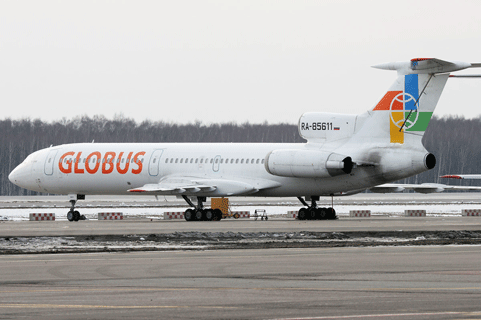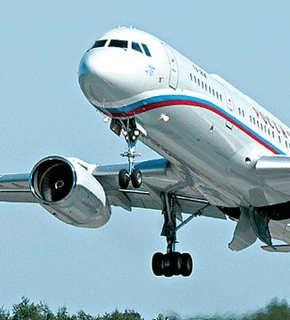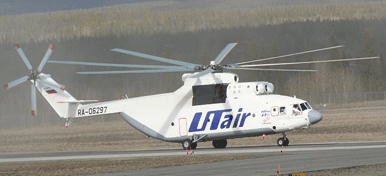|
Operating figures for Russian airlines
show 5% y-o-y decline of revenue passenger kilometers in 11M 2009. Russian
operators, like their foreign peers, have experienced some recovery
in passenger carrying since the 1H 2009, but the recovery has been hampered
by rising prices for fuel in 2009. IATA expects the global industry
to show net losses of USD$10b this year, declining to USD$5b in 2010.
The Russian airline market has potential
to grow faster than the international average due to current low human
mobility, which should rise together with GDP. Expect the concentration
of what remains a fragmented market (there are more than 170 domestic
airlines, mostly with five or fewer jets). The five biggest airlines,
which carry over 60% of passengers, should expand their market share
as small companies with inefficient Soviet craft go out of business:
expect a second wave of airline bankruptcies in 2010-2011, as fuel price
pressure intensifies.
The International Air Transportation Association
(IATA) reports that average passenger load factor in the global airline
industry increased from a low of 71% in January-February 2009 to 77%
in October-November. The Russian industry has fared better than the
U.S. and Europe, but has lagged recovery rates of Middle East and SEA
airlines. Operating performance in Russia and worldwide is still far
below levels in the pre-crisis period. Recovery of airline financials
has been hindered by rise of fuel prices in 2009. For 2010 IATA predicts
positive operating margin and halving of net losses. SEA and the Middle
East should lead the recovery in 2010 due to fastest GDP growth in those
regions.
Revenues passenger kilometers (RPK) in
the Russian airline industry fell by just over 5% y-o-y in 11M 2009.
Two of the five main Russian carriers, UTair and Transaero, avoided
decline, improving their RPK performance by 5% and 11% y-o-y, respectively.
Aeroflot showed average performance. But the other main carriers (Sibir,
UTair and GTK Rossiya) all fared worse than the average.
Russia still has relatively low human
mobility: annual passenger numbers per capita are about 0.5x, which
is equal to Slovakia and significantly lower than most developed markets,
such as France (2x), Germany (2x) and UK (3.7x). So there is strong
potential for industry growth in Russia once the economy recovers.
Most of the Russian civil air fleet still
consists of domestic-built craft, which are much less fuel-efficient
than foreign planes. This makes it hard to achieve profitable operations,
even with a high load factor. The situation is made worse by refueling
monopolies at many regional airports: only airlines, which refuel in
Moscow and St. Petersburg or abroad, can be sure of obtaining fair prices
for fuel.
Russia’s airline industry as mentioned
is still quite fragmented: there are 170 airlines, most of them with
no more than five jets each. The five biggest airlines (Aeroflot, Sibir
Airlines, Transaero, UTair and GTK Rosiya) carried more than 60% of
passengers in 9M 2009. Other players are small regional companies with
Soviet-made planes, few routes and very low margins.
 |
 |
Russian airlines by
passengers carried, 9M 2009 |
| Aeroflot Group |
24% |
| Transaero |
12% |
| Sibir & Globus |
12% |
| GTK Rossiya |
7% |
| UTair |
7% |
| Others |
38% |
| Source:
Federal Agency For Air Transportation |
The combination of an old inefficient
fleet and rising fuel prices could led to a new wave of bankruptcies
among small regional players in 2010. This will create expansion opportunities
for the biggest airlines.
Overall, expect the number of Russian
airlines to decline significantly in the mid-term. The big players (and
other survivors) will use the opportunity to increase their market share,
and their operating results will improve substantially as the Russian
economy recovers and per capita passenger numbers increase.
Aeroflot remains the #1 Russian airline
company, carrying over 22% of Russian passengers in 9M 2009 (including
subsidiaries Donavia and Nordavia). The key event at the company in
2009 was a change of management team. The airline industry veteran,
Valeriy Okulov, was replaced as CEO by Vitaliy Saveliev, a professional
manager, who previously headed the telecom division of AFK Sistema.
The new team has emphasized focus on profitability and seems resolved
to close unprofitable routes, regardless of their political or social
significance (flights to Cairo have been axed; flights to Norilsk ceased
in mid-January). A final version of company strategy is due at the end
of 1Q 2010.
The Group showed healthy 9M 09 operating
results. RPK in 11M fell by only 5% y-o-y, while passenger load factor
was only 1.3% lower y-o-y at 70.2%. Company results have improved much
faster than the overall market since 2H 2009.
Management has very ambitious targets
for 2010: passenger load factor should reach 75%, and the company has
set a target in excess of 25% for y-o-y growth of passenger numbers,
increasing market share. Forecasts are more conservative, but many do
take the company targets seriously and believe that they may be achieved.
Aeroflot Group key operating data and forecast
|
PASSENGER CARRYING
International routes |
2007 |
2008 |
2009E |
2010E |
2011E |
2012E |
2013E |
2014E |
| Passenger turnover, million RPK* |
19,167 |
20,528 |
19,091 |
20,924 |
22,154 |
23,129 |
24,143 |
25,196 |
| Passenger capacity, million ASK** |
27,539 |
29,159 |
27,870 |
29,264 |
30,142 |
31,046 |
31,977 |
32,936 |
| Passenger load factor, % |
69.6% |
70.4% |
68.5% |
71.5% |
73.5% |
74.5% |
75.5% |
76.5% |
| Passenger yield, US cents |
9.91 |
11.01 |
8.26 |
9.50 |
10.45 |
10.97 |
11.52 |
12.09 |
PASSENGER CARRYING
Domestic Routes |
2007 |
2008 |
2009E |
2010E |
2011E |
2012E |
2013E |
2014E |
| Passenger turnover, million RPK |
8,720 |
10,634 |
10,687 |
11,750 |
12,741 |
13,466 |
14,232 |
14,612 |
| Passenger capacity, million ASK |
12 196 |
14 790 |
14 701 |
15 730 |
16 831 |
17 672 |
18,556 |
18,927 |
| Passenger load factor, % |
71.5% |
71.9% |
72.7% |
74.7% |
75.7% |
76.2% |
76.7% |
77.2% |
| Passenger yield, US cents |
10.84 |
11.73 |
8.45 |
10.14 |
10.64 |
10.86 |
11.07 |
11.29 |
| Consolidated data |
2007 |
2008 |
2009E |
2010E |
2011E |
2012E |
2013E |
2014E |
| Passenger turnover, million RPK |
27,887 |
31,162 |
29,778 |
32,673 |
34,895 |
36,595 |
38,375 |
39,808 |
| Passenger capacity, million ASK |
39,735 |
43,949 |
42,571 |
44,993 |
46,972 |
48,718 |
50,533 |
51,863 |
| Passenger load factor, % |
70.2% |
70.9% |
70.0% |
72.6% |
74.3% |
75.1% |
75.9% |
76.8% |
| Passenger yield, US cents |
10.38 |
11.60 |
8.58 |
10.02 |
10.84 |
11.26 |
11.70 |
12.16 |
| CARGO CARRYING |
2007 |
2008 |
2009E |
2010E |
2011E |
2012E |
2013E |
2014E |
| Cargo turnover, million RTK*** |
3,360 |
3,640 |
3,458 |
3,695 |
3,913 |
3,991 |
4,071 |
4,152 |
| Cargo capacity, million ATK**** |
5, 803 |
6,287 |
6,025 |
6,326 |
6,643 |
6,775 |
6,911 |
7,049 |
| Freight load factor, % |
57.9% |
57.9% |
57.4% |
58.4% |
58.9% |
58.9% |
58.9% |
58.9% |
| Cargo yield, US cents |
8.09 |
9.16 |
6.41 |
7.38 |
8.11 |
8.52 |
8.95 |
9.39 |
Source: Company data
*Revenue passenger kilometers
**Aircraft seat kilometers
***Revenue tonne kilometers
**** Aircraft tonne kilometers |
A cost-cutting program this year is targeting
$860m savings compared with the initial budget for 2009. The program
includes reduction of non-operating personnel numbers by about 2,300
(following the pattern of personnel reductions by other international
airlines), and about $240m savings thanks to a new system of fuel purchases,
which includes a hedge strategy and auctions for fuel supplies every
10 days to replace long-term contracts.
Aeroflot has reviewed routes and ticket
pricing, and is closing unprofitable routes, except those, which are
justified by connections with other highly profitable routes (mainly
regional routes inside Russia connecting with international routes via
Moscow). The cost-cutting does not extend to Aeroflot’s fleet
renewal program, which continues unabated and aims to replace all Soviet-built
planes with Airbus, Boeing and Russian-made SSJ-100s in a few years
time.
Aeroflot opened its new terminal at Sheremetyevo
Airport (Sheremetyevo-3) in mid-November and is gradually transferring
all its flights there. The company says that slow pace of the changeover
is intentional, to avoid repeating the disastrous opening of Heathrow-5,
and that 80% of international flights and all domestic flights will
use Sheremetyevo-3 by the end of 1Q 2010. In addition to efficiency
improvements thanks to exclusive operation of a single terminal, Aeroflot
expects to receive nearly $200m revenues from leasing of retail space,
etc. (Aeroflot has a controlling stake in Sheremetyevo-3).
The Group published healthy 9M 2009 financials,
though margins were pulled down by subsidiaries (Donavia, Nordavia and
Aeroflot-Cargo). Losses at subsidiaries have been reduced y-o-y. The
Group’s profitability will likely increase and cost-cutting measures
will likely bring positive effects in 2010-2011. However higher-than-expected
fuel prices could have serious impact on margins.
| Aeroflot Group revenues, $m |
2007 |
2008 |
2009E |
2010E |
2011E |
2012E |
2013E |
2014E |
| Traffic revenue International |
1,900 |
2,260 |
1,576 |
1,987 |
2,314 |
2,537 |
2,780 |
3,047 |
| Domestic |
946 |
1,248 |
903 |
1,191 |
1,356 |
1,462 |
1,576 |
1,650 |
| Charter |
48 |
108 |
76 |
97 |
112 |
123 |
134 |
144 |
| Total passenger revenue |
2,894 |
3,615 |
2,555 |
3,275 |
3,783 |
4,121 |
4,490 |
4,841 |
| Cargo |
272 |
334 |
222 |
273 |
317 |
340 |
364 |
390 |
| Total traffic revenue |
3165 |
3949 |
2777 |
3548 |
4100 |
4461 |
4854 |
5231 |
| Airline revenue agreements |
481 |
477 |
416 |
360 |
235 |
211 |
185 |
156 |
| Ground handling and maintenance |
22 |
25 |
21 |
26 |
26 |
25 |
26 |
29 |
| Other revenue |
139 |
163 |
137 |
163 |
164 |
162 |
169 |
184 |
| Total revenue |
3808 |
4614 |
3351 |
4097 |
4525 |
4860 |
5235 |
5599 |
Source: Company Data
Among second-tiers, the most promising
Russian companies are Transaero, Sibir Airlines and Ural Airlines, which
are ranked #2, 3 and 7 by passenger numbers. All three are expanding
routes and starting new flights in Russia and abroad. They all have
efficient fleets, consisting mainly of foreign jets (Airbus and Boeing).
Transaero is the biggest Russian charter
operator, and is particularly interesting in light of its upcoming IPO
on MICEX. Charter business accounted for about 60% of revenues in 2009
and the foreign-built long- and medium-haul fleet helps to reduce fuel
expenses. Transaero recently obtained government guarantees for debt
refinancing, which is clearly positive.
Transaero shares have an indicative listing
on the RTS-board, but trading has been suspended for the duration of
a share split (intended to raise attractiveness for investors ahead
of the IPO).
Transaero shareholder structure |
| Management |
33.5% |
| DKK - nominee |
31.8% |
| Transaero-Finance |
14.8% |
| ING - nominee |
5% |
| Others |
14.9% |
| Source:
Company data |
Sibir Airlines benefits from a diverse
route network and new fleet. The company also has significant charter
business, which brought about 20% of revenues in 2008. Sibir, like Transaero,
has obtained government guarantees for its debt, which calms concerns
about high debt levels incurred in 2008 due to acquisition of new jets.
The Russian government owns a minority stake in Sibir, which provides
a good hedge in the downturn. Official operating results of Sibir shrank
substantially in 2009 due to transfer of part of routes and fleet to
the 100% subsidiary, Globus.
Sibir Airlines shareholder structure |
| Management |
63.3% |
| Russian Government |
25.5% |
| Others |
11.2% |
| Source:
Company data |
 UTair is ranked as the #5 airline company in
Russia and it includes a helicopter transport business, which has supported
company financials through the downturn. UTair has been among best performers
in 2009, expanding its regional routes after bankruptcy of Air Union
and some of the operators, which were part of Air Union. UTair operates
freight transportation for Russian oil & gas and mining companies,
and also has projects in Congo, Turkey and some other EMEA countries.
UTair is ranked as the #5 airline company in
Russia and it includes a helicopter transport business, which has supported
company financials through the downturn. UTair has been among best performers
in 2009, expanding its regional routes after bankruptcy of Air Union
and some of the operators, which were part of Air Union. UTair operates
freight transportation for Russian oil & gas and mining companies,
and also has projects in Congo, Turkey and some other EMEA countries.
The company has an ADR program and publishes
financial results under IFRS, but there have been delays in publication
of audited figures. The company has opaque shareholder structure. But
the main beneficiary shareholder is believed to be Surgutneftegaz, with
a stake of more than 75%. Surgut has very large cash reserves, adding
to confidence about financial stability of UTair.
UTair’s shareholder structure |
| CSD - nominee |
75.6% |
| DKK - nominee |
7.1% |
| Management |
0.05% |
| Others |
17.25% |
| Source:
Company data |
Ural Airlines is #7 operator in Russia
by passenger numbers. Recent business development and fleet enlargement
made it one of the best performers in 2009: RPK of the company increased
by 1% y-o-y in 10M 2009. Ural Airlines is 74% owned by its 100% subsidiary
Krylya Urala. However, the nature of company shareholder structure is
opaque.
UralAirlines shareholder structure |
| Krylya Urala |
74.4% |
| Beta Investment Holding |
10.3% |
| Management |
0.04% |
| Others |
15.26% |
| Source:
Company data |
Gordon Feller
|




